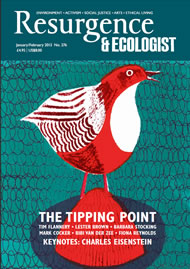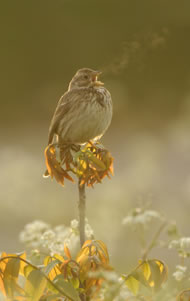“Hope is the thing with feathers,” wrote the 19th-century American poet Emily Dickinson, “That perches in the soul, And sings the tune without the words, And never stops at all.” In truth as I look out my office window hope is not the emotion I most associate with the feathered creatures I see. Take our two most familiar residents, the house sparrow and the starling. The first has declined by 66% in Britain, while the second has dropped by an astonishing 78% in the last 40 years.
If we were to loosen our interpretation of the kind of winged animal bearing hope aloft for Emily Dickinson, then we would be even less consoled. I run a moth trap every week and census my local population, but if the garden bird figures are bad, then the statistics of loss for moths are awful. A third of all British moths have gone since 1968. For 337 species whose population trends can be mapped, two-thirds have declined and 71 have dropped by over 65%. Even for their day-flying cousins the picture is equally bleak. A dismal 72% of British butterflies have declined in the last 10 years.
The American environmentalist Aldo Leopold (see Pioneers page 14) suggested that anyone with an ecological education lives in “a world of wounds”, as they bear witness to Nature being cut down bit by bit. For many it is not the blows that do the damage: it is the amorphous, suffocating shroud of hopelessness that is most unbearable, the sense that the scale of the problem is so vast and the issues so intangible that we are defeated almost before we start.
It is in this context that I found a new book by Andrew Balmford so uplifting. Wild Hope is his attempt to revive our spirits and to find healing stories in a world of wounds. The author travelled on six continents to explore and celebrate various environmental initiatives where the news is good, where the results are positive, and where communities and even national governments have implemented innovative solutions that could easily transform the planet.
Balmford, who is a professor of conservation at Cambridge University, writes beautifully, but more important still, he sees his whole subject as if from a great height. The book is episodic in structure, as he investigates one project after another, and disparate in its sense of geography and scale, as he moves from a town-based afforestation scheme in Ecuador to multi-billion-dollar government programmes in Europe. Yet he is able to weave the various narratives into a single vision. He is also deeply alive to the balance we need to strike between hope on the one hand, and awareness of the hard facts on the other.
Just in case we might accuse him of excessive optimism, Balmford hits us with a few powerful truths of his own. This is a planet that acquires a billion new people every 12 years, where four-fifths of fish stocks are harvested to or beyond sustainable levels, and where half of the world’s temperate forest has now been felled. The main point I take from this eloquent book is that hope and painful truth are inseparable. Environmentalists cannot try to disguise from themselves, or from anyone else, the desperate straits we’re in. The moral of his many stories is that we only find new answers to the problems by absorbing completely the shocking nature of the facts and then rising to meet their challenges.
One story in the book stands out for me, because it offers a way of redressing the catalogue of wildlife losses. Balmford investigated the Dutch initiative entitled the National Ecological Network. Like Britain, the Netherlands is one of the world’s most densely populated countries and has converted to an even higher degree its landscapes for human use. Yet the Dutch want to reverse the trend. The long-term goal, which involves spending close to €1 billion a year, is to revert 17.5% of the landscape back to Nature.
An extraordinary showcase for the scheme is a humanmade landscape at Oostvaardersplassen, a 5,000-hectare wetland reserve near Amsterdam where the wildlife is in charge and the habitat is managed by the grazing jaws of wild horses and cattle that live, breed and die in a completely natural context. The overarching goal is to create a further 300,000 hectares of wild habitat by 2018. To put that figure in context, it is more than the entire landholding of the National Trust and Woodland Trust combined, in a country that is one-sixth the size of Britain. The other wonderful element of the National Ecological Network is its linkage of the disparate parts spread nationwide, using connective corridors. One such wildlife highway has already been established over the main Amsterdam–Utrecht railway line at a cost of €15 million.
What is so inspiring is not only the scale of the resources that the Dutch are putting into this restorative scheme, but also the fact that it is partly government driven and financed. Contrast this with the situation in Britain, where the present administration has emasculated its wildlife agency (Natural England) and more or less abandoned conservation to NGOs such as the National Trust and the RSPB. In effect we have privatised Nature, placing it at the disposal of market forces; wonderful work is performed by many charitable institutions, but they cannot by themselves secure a future for the birds, moths and butterflies that are vanishing daily.
However the Dutch government might articulate its goals, the aim of 17.5% of land for wildlife looks like a whole people engaging in a genuine transaction with Nature, stemming from a recognition that Nature has rights of its own and is fundamental to human welfare. People need trees, flowers, butterflies and birdsong. On this point, Emily Dickinson’s poem makes the case beautifully. That thing with feathers called hope is an indefinable essence fortifying us against all of life’s multitudinous challenges.
But when the birds are gone, then something fundamentally important dies within us.
Wild Hope by Andrew Balmford (University of Chicago Press)








